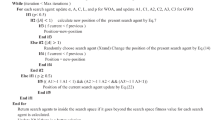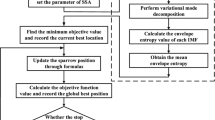Abstract
The complete failure of the rolling bearing is a deterioration process from the incipient weak fault to the severe fault, thus it is important to alarm when the incipient fault appear. This work presents a novel incipient bearing fault diagnosis framework using mode mutual information (MMI) based fitness function, variational mode decomposition (VMD), and cuckoo search (CS) algorithm. MMI based fitness function is proposed in order to obtain the optimal combinations of the VMD parameters. Therefore, the optimal parameters of VMD can be obtained by CS algorithm using proposed fitness function. Afterwards, a vibration signal is decomposed into a set of modes using the optimal VMD, and the kurtosis value of all modes are calculated. The envelop of the mode with maximum kurtosis value between modes and raw signal is computed as the input vector of the stacked denoised autoencoder (SDAE). Comparisons have been conducted via SDAE to evaluate the performance by using EMD and the fixed-parameter VMD. The experimental results demonstrate that the proposed method is more effective in extracting the incipient bearing fault characteristics.
Similar content being viewed by others
References
J. Zarei and J. Poshtan, “Bearing fault detection using wavelet packet transform of induction motor stator current,” Tribology International, vol. 40, no. 5, pp. 763–769, 2007.
A. Kumar and R. Kumar, “Role of signal processing, modeling and decision making in the diagnosis of rolling element bearing defect: A review,” Journal of Nondestructive Evaluation, vol. 38, Article number 5, 2019.
M. Hamadache and D. Lee, “Principal component analysis based signal-to-noise ratio improvement for inchoate faulty signals: Application to ball bearing fault detection,” International Journal of Control, Automation, and Systems, vol. 15, no. 2, pp. 506–517, 2017
N. T. Truong, T.-I. Seo, and S. D. Nguyen, “Bearing fault online identification based on ANFIS,” International Journal of Control, Automation, and Systems, vel. 19, pp. 1703–1714, 2021.
Y. Xiaoan and J. Minping, “Intelligent fault diagnosis of rotating machinery using improved multiscale dispersion entropy and mRMR feature selection,” Knowledge-based Systems, vol. 163, pp. 450–471, 2019.
Y. B. Li, X. Z. Wang, S. B. Si, and S. Q. Huang, “Entropy based fault classification using the case western reserve university data: A benchmark study,” IEEE Transactions on Reliability, vol. 69, no. 2, pp. 754–767, June 2020.
A. Glowacz, W. Glowacz, J. Kozik, K. Piech, and Z. F. Khan, “Detection of deterioration of three-phase induction motor using vibration signals,” Measurement Science Review, vol. 19, no. 6, pp. 241–249, 2019.
G. Wang, M. Du, L. Huang, and L. Li, “Prediction of bearing damage in wind turbines based on the quadratic root mean square of sub-band manifold,” Proc. of the Institution of Mechanical Engineers Part C-Journal of Mechanical Engineering Science, vol. 232, no. 18, pp. 3213–3223, September 2018.
Y. Qin, C. Li, F. Cao, and H. Chen, “A fault dynamic model of high-speed angular contact ball bearings,” Mechanism and Machine Theory, vol. 143, p. 103627, 2020.
H. T. Shi, L. Guo, S. Tan, X. T. Bai, and J. Sun, “Rolling bearing initial fault detection using long short-term memory recurrent network,” IEEE Access, vol. 7, pp. 171559–171569, 2019.
H. Chen, B. Jiang, N. Lu, and Z. Mao, “Deep PCA based real-time incipient fault detection and diagnosis methodology for electrical drive in high-speed trains,” IEEE Transactions on Vehicular Technology, vol. 67, no. 6, pp. 4819–4830, 2018.
Y. Cheng, N. Zhou, W. Zhang, and Z. Wang, “Application of an improved minimum entropy deconvolution method for railway rolling element bearing fault diagnosis,” Journal of Sound & Vibration, vol. 425, pp. 53–69, 2018.
L. Cui, B. Li, J. Ma, and Z. Jin, “Quantitative trend fault diagnosis of a rolling bearing based on Sparsogram and Lempel-Ziv,” Measurement, vol. 128, pp. 410–418, November 2018.
L. Cui, B. Li, J. Ma, and Z. Jin, “Quantitative trend fault diagnosis of a rolling bearing based on Sparsogram and Lempel-Ziv,” Measurement, vol. 128, pp. 410–418, 2018.
T. Y. Wang, Q. K. Han, F. L. Chu, and Z. P. Feng, “Vibration based condition monitoring and fault diagnosis of wind turbine planetary gearbox: A review,” Mechanical Systems and Signal Processing Review, vol. 126, pp. 662–685, July 2019.
Z. X. Hu and H. S. Ma, “Blind modal estimation using smoothed pseudo Wigner-Ville distribution and density peaks clustering,” Measurement Science and Technology, vol. 31, no. 10, p. 105004, October 2020.
S.-S. Lu, Y.-L. Lee, J.-J. Lin, and C. C. Chang, “An EMD-based principal frequency analysis with applications to nonlinear mechanics,” Mechanical Systems and Signal Processing, vol. 150, p. 107300, March 2021.
W. Shuting and Z. Xiong, “Teager energy entropy ratio of wavelet packet transform and its application in bearing fault diagnosis,” Entropy, vol. 20, no. 5, pp. 1–19, 2018.
S. Wan and X. Zhang, “Teager energy entropy ratio of wavelet packet transform and its application in bearing fault diagnosis,” Entropy, vol. 20, no. 5, Article number 388, May 2018.
I. Attoui, N. Fergani, N. Boutasseta, B. Oudjani, M. S. Bouakkaz, and A. Bouraiou, “Multiclass support vector machine based bearing fault detection using vibration signal analysis,” Proc. of the 4th International Conference on Electrical Engineering and Control Applications (ICEECA 2019) Lecture Notes in Electrical Engineering, pp. 885–895, 2021.
X. Yu, F. Dong, E. J. Ding, S. P. Wu, and C. Y. Fan, “Rolling bearing fault diagnosis using modified LFDA and EMD with sensitive feature selection,” IEEE Access, vol. 6, pp. 3715–3730, 2018.
Y. B. Li, G. Y. Li, Y. T. Yang, X. H. Liang, and M. Q. Xu, “A fault diagnosis scheme for planetary gearboxes using adaptive multi-scale morphology filter and modified hierarchical permutation entropy,” Mechanical Systems and Signal Processing, vol. 105, pp. 319–337, May 2018.
Y. Li, M. Xu, X. Liang, and W. Huang, “Application of bandwidth EMD and adaptive multiscale morphology analysis for incipient fault diagnosis of rolling bearings,” IEEE Transactions on Industrial Electronics, vol. 64, no. 8, pp. 6506–6517, August 2017.
X. S. Yang and S. Deb, “Cuckoo search via Lévy flights,” Proc. of 2009 World Congress on Nature & Biologically Inspired Computing (NaBIC), 2010.
H. Qiu, J. Lee, J. Lin, and G. Yu, “The fault characteristic frequency of inner raceway (FO) at 230 Hz,” Journal of Sound & Vibration, vol. 289, no. 4–5, pp. 1066–1090, 2006.
Y. Wang, R. Markert, J. Xiang, and W. Zheng, “Research on variational mode decomposition and its application in detecting rub-impact fault of the rotor system,” Mechanical Systems and Signal Processing, vol. 60–61, pp. 243–251, August 2015.
Funding
This research is supported by the National Natural Science Foundation of China (No.62073141), the National Key Research and Development Program of China (No.2020YFC1522505, No.2020YFC1522502), and Shanghai Natural Science Foundation (No.22ZR1417000).
Author information
Authors and Affiliations
Corresponding author
Additional information
Shuai Tan received her B.S. degree in automation and a Ph.D. degree in control theory and control engineering from Northeastern University, China, in 2005 and 2012, respectively. She is currently an Associate Professor with the East China University of Science and Technology, Shanghai, China. Her research interests include operation state evaluation for complex industrial process, fault monitoring and diagnosis, and machine learning of image information.
Aimin Wang was born in 1997. He received his B.E. degree in automation major from East China University of Science and Technology, China, in 2019. He is currently pursuing a master’s degree in control science and engineering with the School of East China University of Science and Technology, Shanghai, China. His research interests include faults detection of mechanical systems.
Hongbo Shi received his B.E. and Ph.D. degrees in control engineering from East China University of Science and Technology, China, in 1982, and 2000, respectively. He has been a Professor with the School of Information Science and Engineering, East China University of Science and Technology, where he has also been the secretary, since 2013. He is the author of more than 150 articles (SCI/EI), and five patents. His current research interests include industrial process modeling, control and optimization.
Lei Guo was born in 1994. He received his B.S. degree in mechanical design manufacture and automation major from Jiamusi University, China, in 2017 and an M.S. degree in mechanical engineering from the Shenyang University of Technology in 2020. He is currently pursuing a doctoral candidate in control science and engineering with the School of East China University of Science and Technology, Shanghai, China. His research interests include faults detection of mechanical systems.
Publisher’s Note
Springer Nature remains neutral with regard to jurisdictional claims in published maps and institutional affiliations.
Rights and permissions
About this article
Cite this article
Tan, S., Wang, A., Shi, H. et al. Rolling Bearing Incipient Fault Detection via Optimized VMD Using Mode Mutual Information. Int. J. Control Autom. Syst. 20, 1305–1315 (2022). https://doi.org/10.1007/s12555-021-0100-6
Received:
Revised:
Accepted:
Published:
Issue Date:
DOI: https://doi.org/10.1007/s12555-021-0100-6




